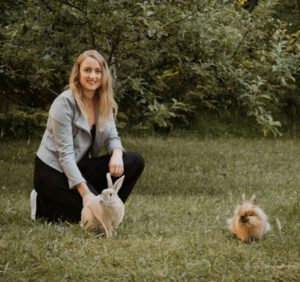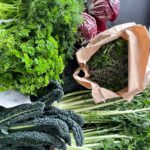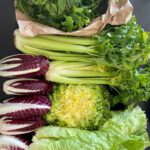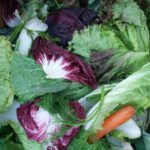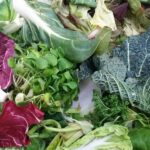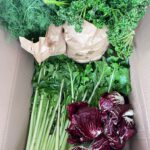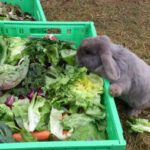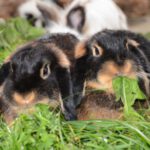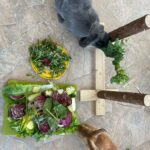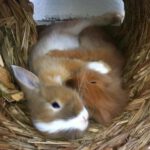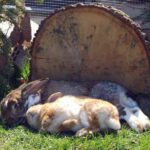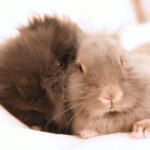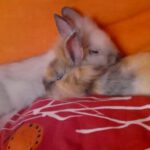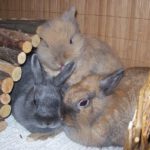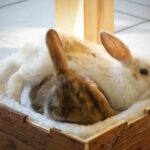Overweight and Obesity
Every third rabbit in Germany is overweight.
Contents
How do I recognize overweight in rabbits?
Rabbits don’t have a fixed ideal weight unless they are purebred with official breeder papers. Even within the same breed, there can be significant natural weight variations.
Attention: In winter, slight overweight is normal (winter fat!), even for indoor rabbits. It just needs to be lost again by April/May.
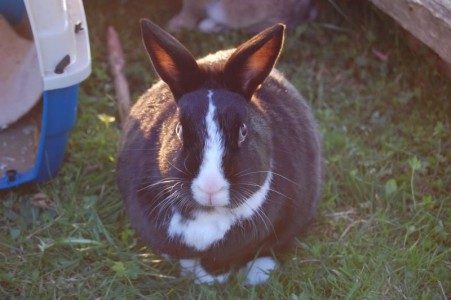
Very thin
- The hip bones, ribs, and spine are sharp to the touch.
- Muscle loss and no fat layer.
- The hindquarters of the rabbit are sunken.
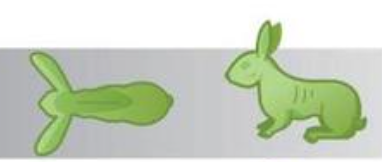
Underweight
- The hip bones, ribs, and spine are easily felt.
- Few muscles and a very thin layer of fat.
- The hindquarters are flat.

Normal
- The hip bones, ribs, and spine are palpable but rounded, not sharp—the ribs feel like a bag filled with pencils.
- Slight abdominal bulge.
- The hindquarters are rounded.

Overweight
- It requires pressure to feel the ribs.
- Significant layer of fat.
- The hindquarters are rounded.

Obesity
- The hip bones, ribs, and spine are difficult or impossible to feel and lie beneath a thick layer of fat.
- The belly is sagging, and there is a flabby layer of fat present.
- The hindquarters are protruding.

A rabbit is considered overweight if…
- It has fat deposits (except for the dewlap, which is present even in normal-weight rabbits but is less filled).
- The spine is no longer palpable.
- The ribs are difficult to feel.
The best way to check the ribs is by feeling them just behind the elbow. If the ribs feel like a pencil case filled with sharp rulers, the rabbit is underweight. If they are easily felt and have sharp edges, the rabbit is overweight. If the ribs feel like a pencil case filled with pens, the rabbit has an ideal weight. For an overweight rabbit, it takes pressure to feel the ribs, while in an obese rabbit, they cannot be felt at all.
Sore feet (pododermatitis) and a dirty rear end or „mushy feces“ (the cecotropes are not being properly consumed because the rabbit cannot reach them) are also very common signs of overweight.
Excess weight leads to many health issues
Pressure sores and wounds (pododermatitis) on the feet due to weight strain on the skin. Rabbits do not have pads, meaning their skin is in direct contact with the bone; excess weight and an unsuitable surface can cause such pressure sores. These sores are often hidden under the fur, so overweight rabbits should be carefully examined on their feet.
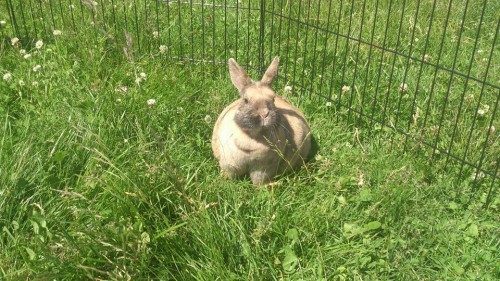
Fatty infiltration of internal organs (e.g., fatty liver) is one of the most common causes of death and often leads to sudden death!
- Increased risk during anesthesia
- Reduced life expectancy (by about 20%, meaning a rabbit that would live to be 8 years at normal weight will only live about 6.4 years when overweight)
- Strain on joints and the entire musculoskeletal system, leading to secondary conditions (arthritis, etc.)
- Cardiovascular problems
- Respiratory issues if fat accumulates in the chest
- Increased susceptibility to diseases (weakened immune system)
- Digestive problems due to restricted digestion (gastric dilatation, constipation, bloating, etc.)
- Cecotropes sticking to the po because the rabbit cannot reach them to consume them is a particular concern associated with being overweight.
Particularly concerning is overweight caused by lack of exercise (and poor diet). Overweight rabbits that are active and properly fed tend to be healthier.
No zero diet! Not providing food for rabbits can be fatal, as they depend on a continuous food supply. Moreover, such an approach is not sensible.
Hay diet? Hay is more energy-rich than many people think, and it is not sufficient to provide the rabbit with all essential vitamins in adequate amounts. Therefore, a hay diet is not recommended as it can be harmful to health. However, it is advisable to choose a less popular hay that is low in herbs.
Main Causes of Obesity in Rabbits:
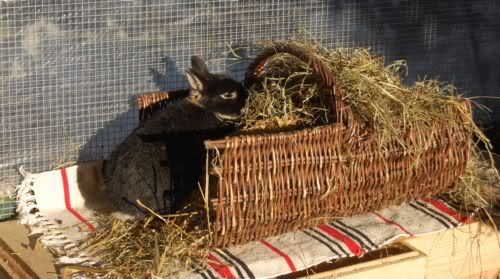
- Dry food of all kinds (including grain-free food, veterinarian-recommended pellets, breeder pellets, dried herbs, seeds, etc.)
- Hard bread (it does not help with dental wear, harms digestion, and leads to overweight)
- Treats and snacks (yogurt drops, green rolls, rings, pea flakes, etc.)
- Human food (children often give their rabbits some of their sweets)
- Overall high energy content in the diet (e.g., too many oats, seeds, root vegetables, fruits, etc.)
- A diet high in roots or fruits
- Generally poor nutrition (too much processed and dry food, not enough varied leafy greens)
- Too energy-dense fresh food (herbs, cabbage, favorite fresh food): Rabbits tend to select based on energy content; they should not only eat their favorite food but also have periods where they eat leftovers they don’t prefer.
- Hay that is too rich in herbs; ideally, it should be a more fibrous, green hay that is not too popular and is consumed only as a supplement.
- Insufficient exercise and variety (too small of a living space, little or no free range, solitary housing, cage housing, or stall housing)
- Solitary rabbits can become depressed, leading to obesity due to lack of movement. Having a companion is essential!
- A slow metabolism due to a very dry diet (often from dried herbs/herb-rich hay) frequently leads to obesity. Fresh food as the main diet, like cabbage, clover, etc., stimulates digestion and metabolism.
- Some metabolic disorders can cause obesity, particularly Euthyroid Sick Syndrome (ESS), which is often overlooked. Rabbits with underlying health conditions often become overweight because they produce fewer thyroid hormones. Therefore, T4 should be tested in the blood, and other conditions should be ruled out (blood check, thorough examination, and X-rays by a veterinarian experienced with rabbits).
- Other diseases can also be causative, such as those that restrict movement, often joint diseases.
- Pain can also contribute to reluctance to move, leading to significant weight gain. Possible causes include undiagnosed ear infections or bladder infections due to sediment.
- Some rabbits have a hereditary predisposition to fat deposits, such as certain meat rabbit breeds.
- Lack of variety that encourages movement. In indoor housing, rabbits should be engaged with their food (scattered, hung up, hidden, or requiring effort to obtain).
Address the Cause First
Provide your rabbit with a living space that offers several square meters of floor area both day and night (for indoor or outdoor housing), a companion of the opposite sex, and plenty of variety (change the setup daily and provide additional space to run!). Hide and scatter the food throughout the area. Hang food from a thick string at an elevated height and use puzzle feeders. If the weight continues to increase despite these changes, there is often an underlying health issue. Consult a veterinarian.
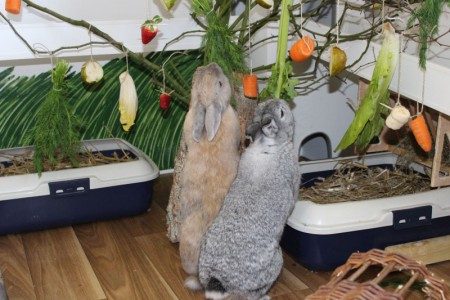
What Should Overweight Rabbits Eat?
Obesity in rabbits often, but not always, has simple underlying causes: improper diet and/or housing. Additionally, rabbits frequently become overweight if they are less active due to another health issue, if their hormones are affected by a condition, or if their environment is relatively unstimulating (e.g., indoor housing). Once the causes are addressed, the excess weight can typically resolve on its own within a few weeks, and especially in a sustainable manner.
To lose weight, however, the diet should be slightly below their energy needs to ensure a caloric deficit!
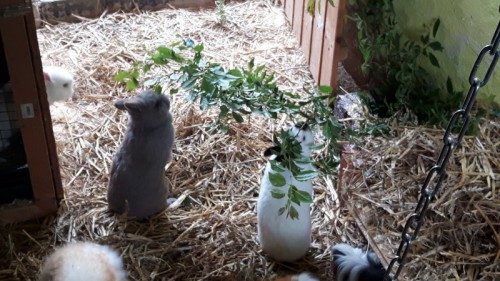
Provide a balanced diet with plenty of fresh food (always offer enough to last until the next meal), particularly leafy greens (a mix of meadow plants, branches, minimal kitchen herbs, limited cabbage, and plenty of bitter greens) that is supplemented with hay and water (both should always be available). Dry food, oats, flour seeds, snacks, hard bread, dried herbs, and chew sticks should be completely eliminated from their diet; fresh herbs (e.g., dill) are suitable as treats. Fresh branches are also great for chewing.
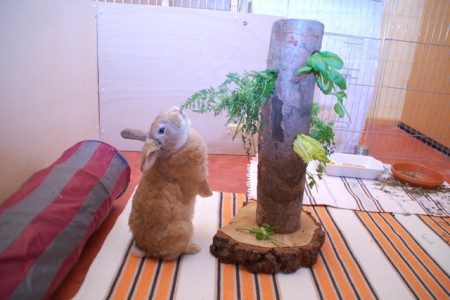
Food for Weight Loss
Rabbits tend to select the food that contains the most energy first. In the wild, energy is scarce, and these animals need to move a lot to find food; therefore, this behavior is completely natural. In domestic settings, however, there are hardly any natural predators, and the animals tend to be less active and have fewer health challenges to contend with.
The more preferred leafy greens are often the primary contributors to weight gain in your rabbits. Therefore, it’s important to significantly reduce these and instead offer less favored greens. It’s sufficient if only a small piece of bok choy and a bit of endive salad are left over for the next feeding; there’s no need to provide their energy-rich favorite food throughout the day! By limiting these high-energy options, they will become less picky, their metabolism will be stimulated, and they will lose weight!
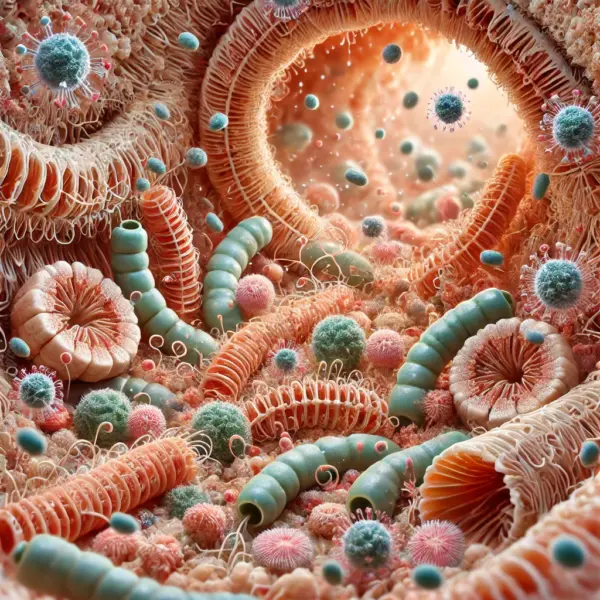
Can I simply reduce the amount of fresh food?
No, that is not advisable (see hay as the main food?). Hay is more energy-dense than fresh food (it’s a concentrate) and activates a dry metabolism that slows down the overall metabolism, which can lead to even more weight gain.
Encourage Active Foraging for Food:
- Get feeders that can be hung high enough so the rabbits have to work to access their food. Ideally, use feeders that make it more challenging to pull the food out.
- Place a grid behind the litter box and attach food with clothespins so they have to stretch to reach it.
- You can string a line across the enclosure and use clothespins to hang the food high enough that they need to work for it!
- Introduce different levels (such as small tables, which can be found cheaply online) and offer food there to encourage them to hop up and move around.
- Always feed in various locations and hide the food in the hay or around the enclosure so they have to search for it instead of just walking from their sleeping area to the feeding spot and back.
- Engage in activities like clicker training, agility, and other exercises to promote more movement.
- If your rabbits have access to free range (e.g., in the house or garden), feed them only during those times in the free-range area, not in their enclosure. For garden free range, allow them to graze for their food without providing any additional food to encourage movement.

The following vegetable varieties are particularly low in energy: celery, cucumber, spinach, all types of lettuce (endive, head lettuce, lamb’s lettuce, chicory, radicchio, etc.), bok choy, bell peppers, and tomatoes. However, it is important not to feed only these vegetables; other leafy greens must also be provided. The focus should be on leafy greens (such as chicory, endive, frisée lettuce, dandelion greens, bok choy, etc.), twigs, grasses, and meadow herbs.
If the rabbit gains weight despite a diet consisting solely of meadow plants, the composition should be adjusted to include two-thirds grasses. It’s important to offer not too young grass, but rather slightly taller herbs and grasses, as they are lower in energy. In winter, the diet should mainly consist of bitter greens and twigs, supplemented with energy-poor fresh food and only a small amount of cabbage leaves and kitchen herbs.
How Much Should My Rabbit Lose?
Rabbits should aim to lose about 1% of their body weight per week. Rapid weight loss can quickly lead to fatty liver disease in rabbits!



Engaging rabbits through their food, providing plenty of variety by keeping them close to humans in their housing, and incorporating enough levels and rearranging the setup can encourage them to move!
Underweight, Weight Loss
Progressive underweight is a very complex condition with numerous potential causes. It can be categorized into two types:
- Underweight due to picky eating, reduced food intake, lack of food, or decreased eating behavior (nutritional deficiency/energy deficiency).
- Weight loss despite consistent or increased eating behavior (debilitating diseases).
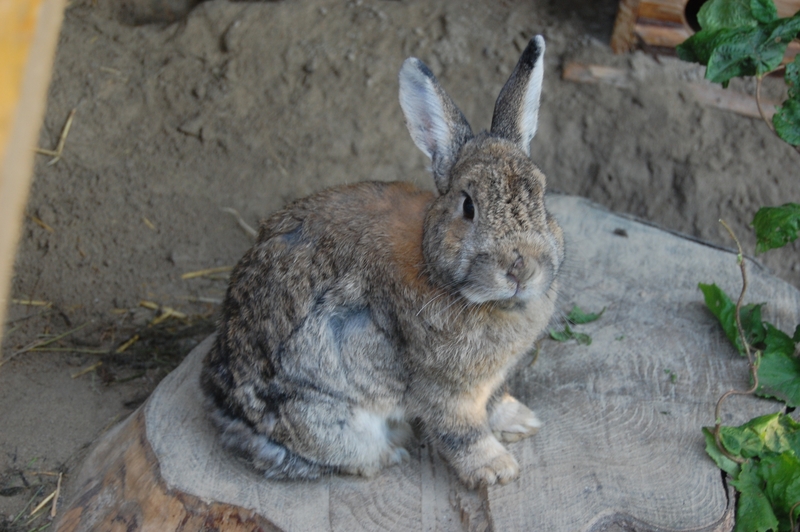
To determine the underlying cause, the following diagnostics are essential:
Underweight, Weight Loss
Progressive underweight is a very complex condition with numerous potential causes. It can be categorized into two types:
- Underweight due to picky eating, reduced food intake, lack of food, or decreased eating behavior (nutritional deficiency/energy deficiency).
- Weight loss despite consistent or increased eating behavior (debilitating diseases).
To determine the underlying cause, the following diagnostics are essential:
The Rabbit Is Eating Less or Not at All:
- A thorough general examination (to check for other diseases).
- A detailed dental examination (to look for dental issues), possibly with X-rays from four different angles.
- Blood tests (pet profile to rule out organic causes, plus IgG and IgM for E. cuniculi titers).
- Fecal samples collected over two to three consecutive days to check for parasites (and bacteria in the case of diarrhea).
- Possible urine examination.
- Possible X-rays (of the heart, teeth, digestive system, etc.).
The Rabbit Is Eating Well or More Than Usual:
- Fecal samples collected over 2-3 days (to check for worms, coccidia, yeast, etc.).
- Is the feeding adequate? Is the rabbit growing? Is there any stress (e.g., bullying within the group)? Is the rabbit elderly?
- A thorough general examination (to look for other symptoms of disease).
- Blood and urine tests (e.g., for diabetes, thyroid disease or Euthyroid-Sick-Syndrome (ESS) – T4 levels; kidney or liver diseases).
- Possible underlying conditions, such as a tumor.
- Is there diarrhea?
- Genetic condition Megacolon (spotting pattern?).
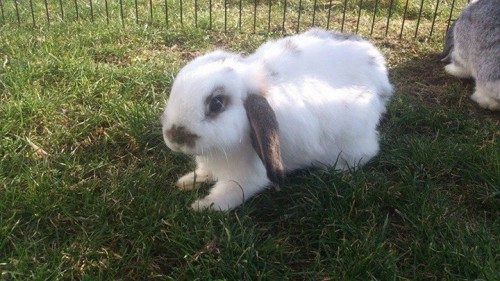
Treatment
The first step is to address the underlying cause, as failing to do so will result in continued weight loss. If the cause cannot be resolved, energy-rich food may be introduced to increase caloric intake. However, this carries the risk of yeast overgrowth, which can lead to diarrhea.
In addition to a constant supply of leafy greens (such as cabbage, meadow plants, fresh tree leaves, kitchen herbs, vegetable greens, and bitter greens), a small amount of energy-rich food (like oats, seeds, or banana, and possibly soaked dry food like Cuni Complete) should be offered. Each rabbit tolerates energy-rich diets differently; some may experience excessive yeast growth, leading to diarrhea.
Therefore, such energy-rich food should only be given in small amounts and ideally several times a day, in conjunction with a stable, species-appropriate diet, while closely monitoring the rabbit’s digestion. If the rabbit cannot tolerate a specific energy source, it should be changed.
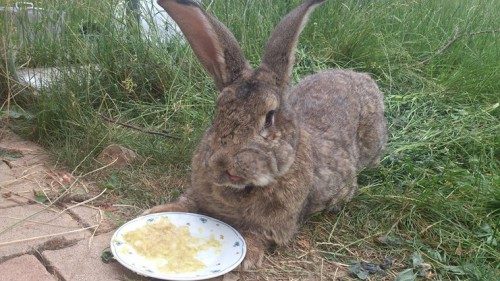
Weight Progress/Experience Report on Weight Loss
Emil is losing weight…


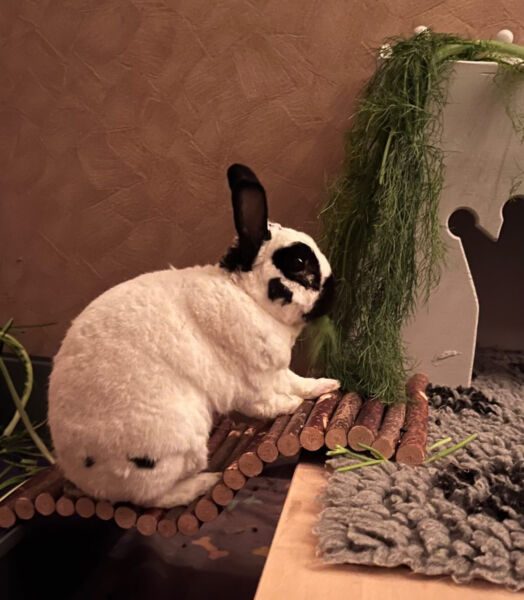

Rabbit Diet
„Bonny came to us from the shelter weighing 4 kg; she was a found rabbit. She lost weight down to 2.5 kg through exercise and green feeding until her death (tumor in her jaw).“

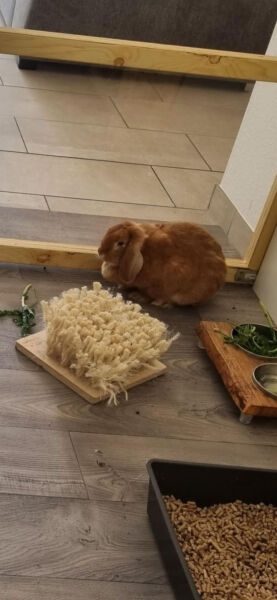
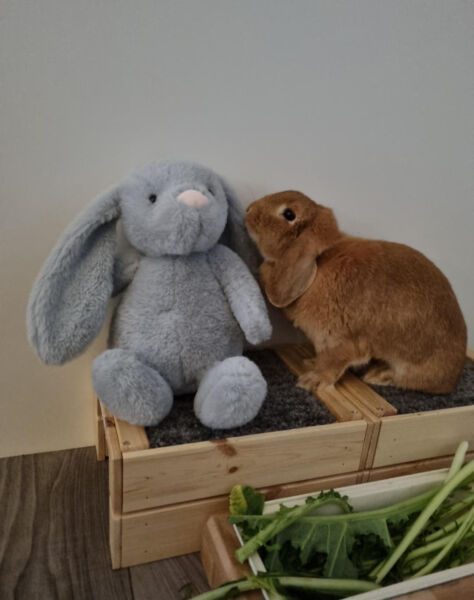
Sources include:
Ewringmann, A. (2010): Leitsymptome beim Kaninchen: diagnostischer Leitfaden und Therapie; 33 Tabellen. Georg Thieme Verlag.
Glöckner, B. (2016): Adipositas beim Kaninchen. team. konkret, 12(02), 4-7.
Reusch, B. (2010): Why do I need to body condition score my rabbit. Rabbiting On, 10-11.


